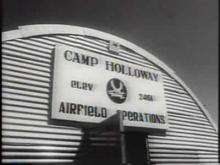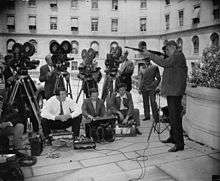Newsreel

A newsreel is a form of short documentary film prevalent in the first half of the twentieth century, regularly released in a public presentation place and containing filmed news stories and items of topical interest. It was a source of news, current affairs, and entertainment for millions of moviegoers until television supplanted its role in the 1950s. Newsreels are now considered significant historical documents, since they are often the only audiovisual record of historical and cultural events of those times.[1]
Newsreels were typically exhibited as short subjects preceding the main feature film into the 1960s. There were dedicated newsreel theaters in many major cities in the 1930s and 1940s,[2] and some large city cinemas also included a smaller theaterette where newsreels were screened continuously throughout the day.
History

Created in 1911 by Charles Pathé, this form of film was a staple of the typical North American, British, and Commonwealth countries (especially Canada, Australia, and New Zealand), and throughout European cinema programming schedule from the silent era until the 1960s when television news broadcasting completely supplanted its role. The National Film and Sound Archive in Australia holds the Cinesound Movietone Australian Newsreel Collection, a comprehensive collection of 4,000 newsreel films and documentaries representing news stories covering all major events.
The first official British news cinema that only showed newsreels was the Daily Bioscope that opened in London on 23 May 1909.[3] In 1929 William Fox purchased a former Broadway theater called the Embassy (now a visitor center operated by the Times Square Alliance[4]). He changed the format from a $2 show twice a day to a continuous 25 cent programme establishing the first newsreel theater in the USA. The idea was such a success that Fox and his backers announced they would start a chain of newsreel theaters across the USA.[5] The newsreels were often accompanied by cartoons or short subjects.
In some countries, newsreels generally used music as a background for usually silent on-site film footage. In some countries, the narrator used humorous remarks for light-hearted or non-tragic stories. In the U.S., newsreel series included The March of Time (1935–1951), Pathé News (1910–1956), Paramount News (1927–1957), Fox Movietone News (1928–1963), Hearst Metrotone News (1914–1967), and Universal Newsreel (1929–1967). Pathé News was distributed by RKO Radio Pictures from 1931 to 1947, and then by Warner Brothers from 1947 to 1956.
On August 12, 1949, 120 cinema technicians employed by Associated British Pathé in London went on strike to protest the dismissal of fifteen men on the grounds of redundancy while conciliation under trade union agreements was pending. Their strike lasted through to at least Tuesday the 16th August, the Tuesday being the last day for production on new newsreels shown on the Thursday. Events of the strike resulted in over three hundred cinemas across Britain having to go without newsreels that week.[6]
An example of a newsreel story is in the film Citizen Kane (1941), which was prepared by RKO's actual newsreel staff. Citizen Kane includes a fictional newsreel "News on the March" that summarizes the life of title character Charles Foster Kane while parodying The March of Time.
Retrospectives
A 1978 Australian film, Newsfront, is a drama about the newsreel business.
Effect of television
On February 16, 1948, NBC launched a ten-minute television program called Camel Newsreel Theatre with John Cameron Swayze that featured newsreels with Swayze doing voiceovers. Also in 1948, the DuMont Television Network launched two short-lived newsreel series, Camera Headlines and I.N.S. Telenews, the latter in cooperation with Hearst's International News Service.
On August 15, 1948, CBS started their evening television news program Douglas Edwards and the News. Later the NBC, CBS, and ABC news shows all produced their own news film. Newsreel cinemas either closed or went to showing continuous programmes of cartoons and short subjects, such as the London Victoria Station News Cinema, later Cartoon Cinema that opened in 1933 and closed in 1981.
Newsreels died out because of technological advances such as electronic news-gathering for television news, introduced in the 1970s, rendered them obsolete. Nonetheless, some countries such as Cuba, Japan, and Spain continued producing newsreels into the 1980s and 1990s.[7] Newsreel-producing companies excluded television companies from their distribution, but the television companies countered by sending their own cameramen to film news events.
See also
- List of newsreels by country
- The March of Time newsreel series produced by Time-Life from 1935 to 1951
- Universal Newsreel newsreel series produced by Universal Studios from 1929 to 1967
- Hearst Metrotone News newsreel series produced by Hearst Corporation from 1914 to 1967 (distributed by Fox Film Corporation 1929-1934 and by MGM 1934-1967)
- Fox Movietone News produced by Fox 1928 to 1963
- Paramount News newsreel series produced by Paramount Pictures from 1927 to 1957
- Pathé News newsreel series produced by Pathé Film from 1910 to 1956 (distributed by RKO Radio Pictures 1931-1947 and by Warner Brothers 1947-1956)
References
- ↑ Australian Screen: Cine sound Movie tone Australian Newsreel Collection (1929 - 1975)
- ↑ King, Barrie, Newsreels, Oz Film, Culture and Communication Reading Room, Murdoch University
- ↑ p. 56 Popple Simon & Kember, Joe Early Cinema: From Factory Gate to Dream Factory Wallflower Press 2004
- ↑ Times Square Alliance Business Improvement District Embassy Theater
- ↑ "Newsreel Theater". Time magazine. November 18, 1929. Retrieved 2008-10-31.
The six or seven minutes of newsreel exhibited in ordinary program houses are selected from many reels of current events. Nowhere could one be sure of seeing all the newsreels made in any one week. In Manhattan, William Fox, in collaboration with Hearst Metro tone, found what to do with the newsreels discarded weekly by their companies. He took over a Broadway theater (Embassy) and changed its program from a $2 show twice a day to a continuous 25¢ show. He made the program all newsreels, to run for an hour, a full photographic report of the pictorial parts of the week's news.
- ↑ "No Newsreels in 300 Cinemas: Technicians On Strike". The Glasgow Herald. August 17, 1949. Retrieved 2013-08-04.
- ↑ Original Negative of the Noticiero ICAIC Lationamericano
Further reading
- Baechlin, Peter and Maurice Muller-Strauss (Editors), Newsreels across the world, Paris: Unesco, 1952
- Barnouw, Erik, Documentary: a history of the non-fiction film, Oxford: Oxford University Press, 1993 revised
- Clyde, Jeavons, Jane Mercer and Daniela Kirchner (Editors), "The story of the century!" An international newsfilm conference, London: BUFVC, 1998
- Fielding, Raymond (2011). The American Newsreel: A Complete History, 1911-1967. Jefferson, N.C.: McFarland. ISBN 0786466103.
- Fielding, Raymond, The March of Time, 1935-1951, New York: Oxford University Press, 1978
- Imesch, Kornelia; Schade, Sigrid; Sieber, Samuel (Editors), Constructions of Cultural Identities in Newsreel Cinema and Television after 1945, Bielefeld: transcript, 2016.
- McKernan, Luke (Editor), Yesterday's news. The British Cinema Newsreel Reader, London: BUFVC, 2002
- Smither, Roger and Wolfgang Klaue (Editors), Newsreels in film archives: a survey based on the FIAF symposium, Wiltshire: Flicks Books, 1996
- Vande Winkel, Roel, "Newsreel series: world overview", in: Aitken, Ian (Editor), Encyclopedia of the Documentary Film, New York/London: Routledge, 2006, pp. 985–991
External links
| Wikimedia Commons has media related to Newsreels. |